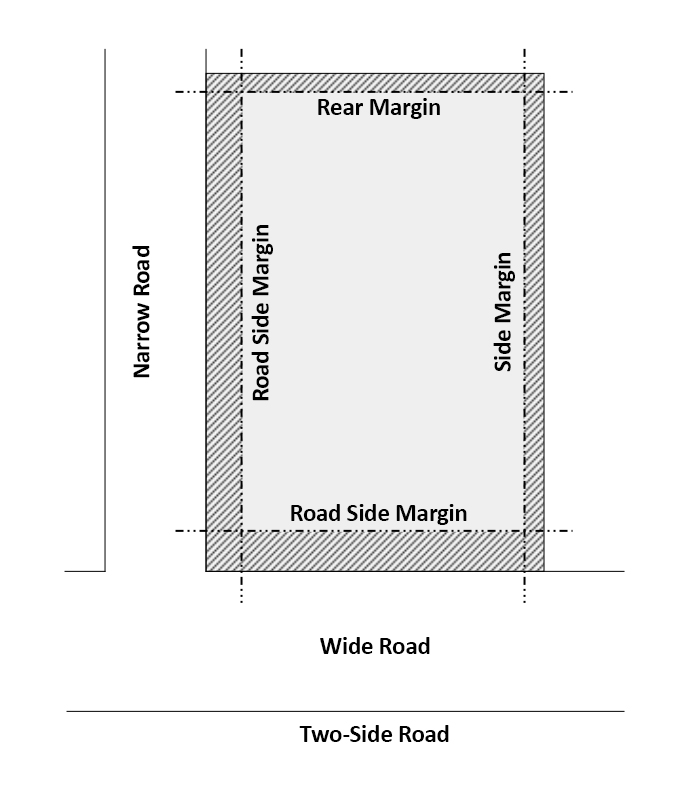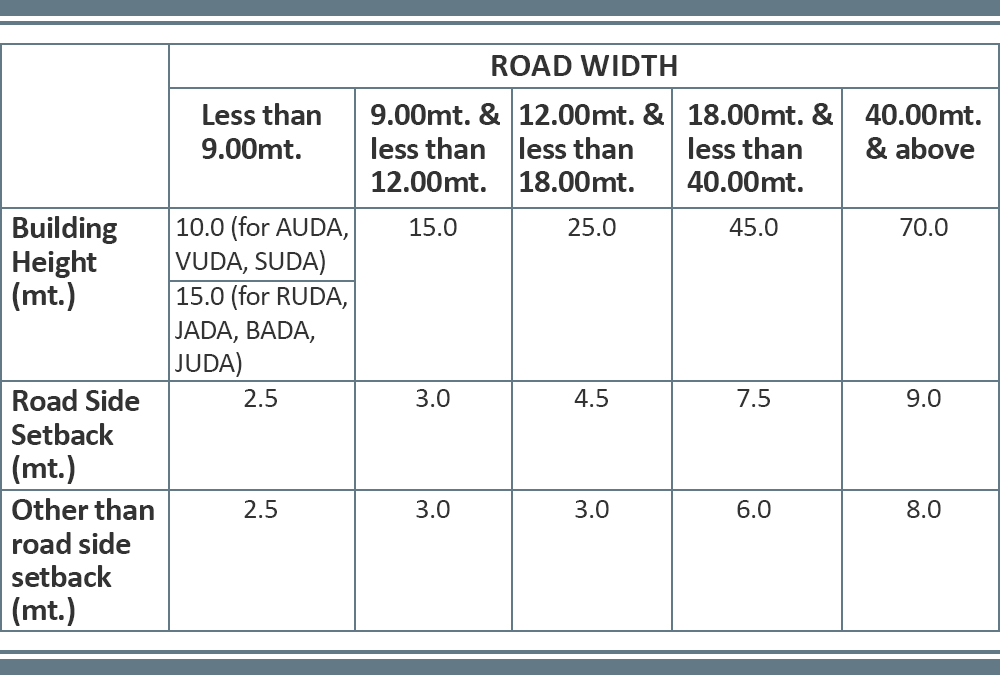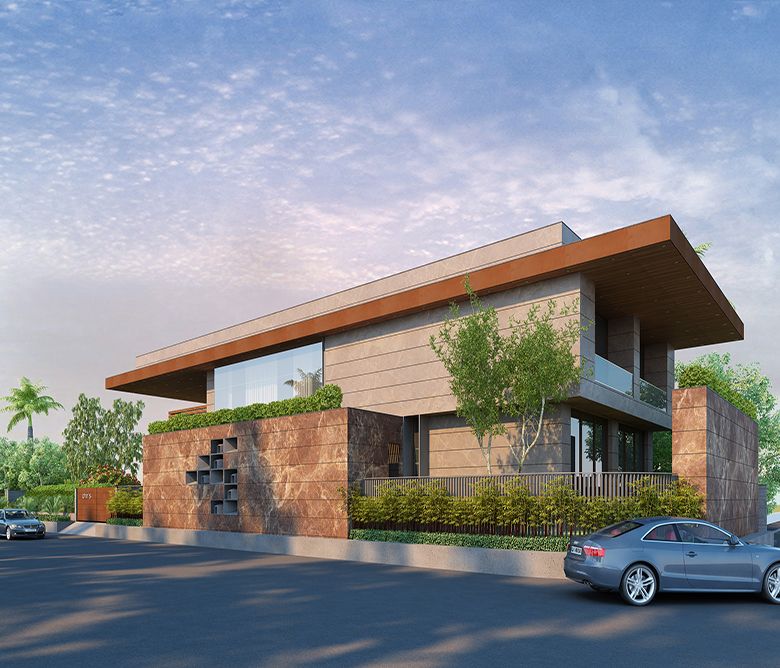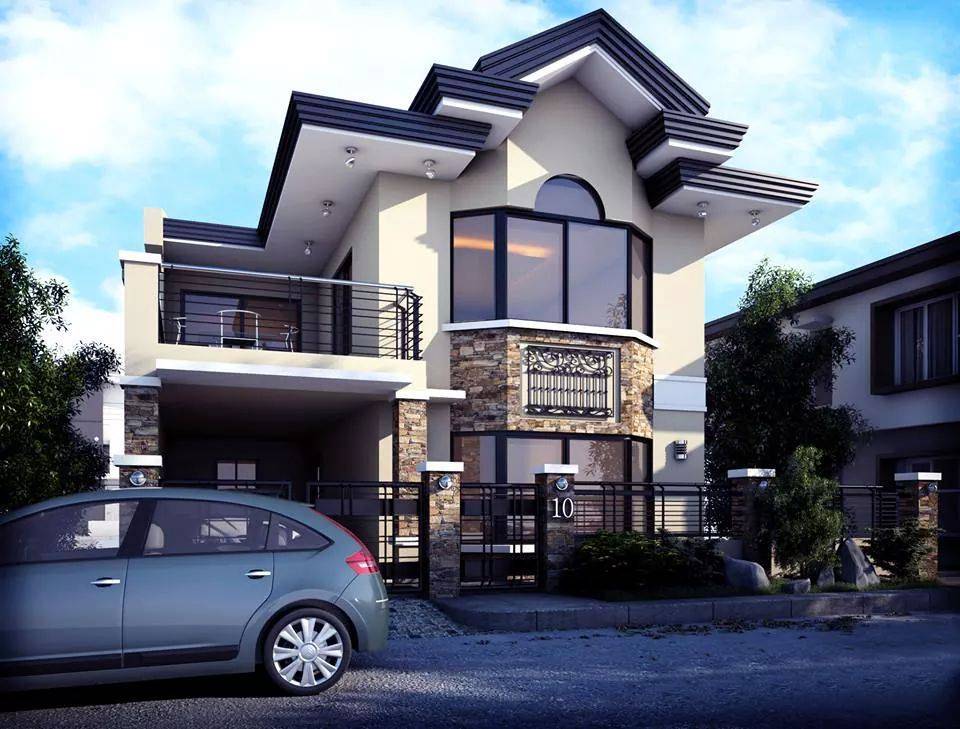
Table of Contents
Quick Summary
- Building setback is the minimum open space that is required to be left around any building or a structure.
- It ensures an adequate amount of natural light, ventilation, parking, etc.
- Building setbacks are of three types, namely road side margin, side margin, and rear margin.
- Factors affecting width of a building setback are the size of the plot, width of the road, locality, and surroundings.
- Permissible uses of building setbacks are projections, sunshades, porch, parking areas, and many more.
- Measuring building setback is done horizontally form the edge of the building to the edge to the plot.
Building construction is one of the technical subjects that comprises of huge numbers of puzzling terms with their minimum requirements. Amongst these terms, building setback is one of the vital terms about which most of the people are yet unaware. Thus, Gharpedia is here for demystifying everything about the term building setback with its significance in construction industry.
What is Building Setback?
Building setback is the minimum open space that is required to be left around any building or a structure as per the norms stated by local development authority. On a site plan, building setbacks are indicated in the form of setback lines. These building setbacks ensures that the buildings stays away from other adjacent buildings, roads, or any adjacent water body. Any plan for the construction of the building should provide setback/setback from the boundary of the plot or road. Bottom of ForLet’s have a look at the importance of building setbacks and why does local development authority insists for providing setbacks as a public policy for health, safety and privacy.
Importance of leaving Building Setback
- Building setback ensures that the building occupants gets adequate amount of natural light.
- If building setbacks are left, it also helps in providing good natural ventilation.
- Building setbacks protects the building from the shadow of another building so that it does not obstruct the natural light and ventilation coming in the interiors of the building.
- It also facilitates movement of vehicles around the building including fire tenders in case of an emergency.
- Building setbacks ensures easy access to the building.
- Setback spaces are also used for parking space for vehicles.
- In some cases, it is also used as Landscaping / garden area around the building.
- If there is any water body nearer to the building, setbacks helps to protect such entities from being affected by construction of building.
- In addition, Infrastructure services like water supply, sewerage, storm water drain, gas line, power connection etc., are normally laid out in this space.
Hence the setbackal space is very important for enjoying the house or a building. So, let’s have a glance at various types of building setbacks.
Types of Building Setbacks
There are three types of building setbacks that are supposed to be considered while building a house as stated below:
01. Road Side Margin:
Road side margin means the space provided in front from the road side edge to the building.
02. Side Margin:
Side margin means the space provided on all the other sides of the building.
03. Rear Margin:
Rear margin means the space provided from the back or rear edge of the building.
The setback lines can be seen in the below site plan.

According to local development authority like Municipality, Corporation or even panchayat one has to provide this setback from roads / boundary to new proposed building. All these setbacks differ from each other depending on various factors like height of building, width of roads, etc. So, let’s have a look at factors affecting the width of setback.
Factors Affecting Width Of Building Setback
Various aspects defining the width of building setback are:
- Size of plot on which building is to be built.
- Width of road adjacent to the road.
- Whether the plot is only one-side open plot or multi-side open plot.
- Locality and surroundings of plot.
- Maximum permitted built up area locality.
Along with these factors defining the width of setbacks, setbacks also depend on the following factors:
- Local development Authority Regulation.
- Location of site within city
- Type of Structure, Public / private / institutional and it use
- Low rise or High rise structure
- Type of road on which the property abuts
- Tenure of land (e.g. Gamtal land allowing 80% to 100% construction, Non-agricultural land etc)
Prior than these factors, every different area and the city have different regulations regarding these setbacks. To explain this concept in a better way, let’s take some examples.
Building Setback Rules and Regulations for Gujarat, India
The rules and regulations for building setbacks as per Gujarat Comprehensive Development Control Regulations (GDCR) – 2017 are as stated below:

Building Setback Rules and Regulations for Maharashtra, India
The rules and regulations for building setbacks as per Draft Development Control and Promotion Regulations for D Class Municipal Corporation – 2015 in Maharashtra are as stated below:

As we saw, though both the states Gujarat and Maharashtra are situated in same country, i.e., India, the rules related to setbacks are different. Thus, it is advisable to refer the development regulations of your area before leaving setbacks for your building.
Gujarat will now have a common regulation rules, below article shows updates on the new GDCR of Gujarat state.
As setbacks/Setback means open to sky land provided at plot level, you are not allowed to do any construction in the setback either above or below the ground. Only specific construction is permitted in setback area. So, let’s have a look at permissible uses of setbacks.
Permissible Uses Of Building Setbacks
Along with the rules and regulations concerning the setbacks, the permissible uses of setbacks also varies with different areas. But, some of the common permissible uses are stated below:
- Architectural Projections

- Sunshades/chhajjas

- Balconies above ground floor at minimum height of 3.65m from ground level and not at lower level.

- Porch

- Parking area

- Open to sky verandah

Read the below article for creating your own mesmerizing verandah:
Now let’s see how you can measure setback from your building.
Measuring Building Setbacks
Building setback is measured horizontally from the edge of the building to the edge of the plot.
As we saw earlier, margins are defined as front, back & side margins. Normally, road side setbacks are larger whereas the side and rear setbacks are smaller comparatively.
Summing up
building setbacks are very important and neither authority nor any court will regularize it. If you are sued for violation the same, you will have no option but to demolish anything constructed within setback. Hence respect the laws and live peacefully.
Also, if you are thinking to buy new house or construct new house, and if you are interested in knowing about building construction before it gets started, here are some blogs we would like you to have a look on:
Can I Start Construction Without Permission From Local Authority?
What Does FSI in Building Construction Mean?
Do you still have questions and queries? We have a list of frequently asked questions from our clients and valued readers.
Building Setback FAQs
01. What is the minimum setback for a residential building?
The setback for a residential building depends on the height of the structure and it varies according to local authority regulations. So it is advised to refer the local authority development rules.
02. Can setback violations affect property transfer?
Yes, it is important that the setbacks are as per regional norms. In case you buy a house without checking and if there are any violations, you can end up losing the property.
03. Does one have to maintain building setback all over India?
The building setback has to be maintained irrespective of where you in India. If setbacks are not in accordance with the regulations, violations can lead to a legal action towards the owner.
04. What is a setback distance?
Setback distance is generally measured in feet, and calculated between a house or a structure from front, side and rear, from the property lines.
References
Gujrera. (n.d.). Gujarat Comprehensive Development Control Regulations – 2017. [online] Available at: https://gujrera.gujarat.gov.in/resources/staticpage/FINAL_Comprehencive_GDCR.pdf
Nanded Waghala City Municipal Corporation. (n.d.). Draft Development Control and Promotion Regulations for D Class Municipal Corporations in Maharashtra. [online] Available at: https://nwcmc.gov.in/files/tp/D%20class%20Final%2019-11-15…..pdf
































